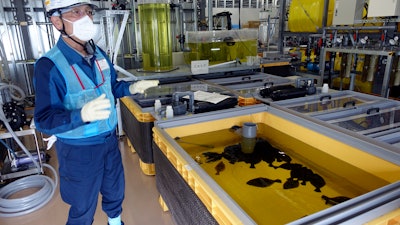
OKUMA, Japan (AP) — Twelve years after the triple reactor meltdowns at the Fukushima Daiichi nuclear power plant, Japan is preparing to release a massive amount of treated radioactive wastewater into the sea.
Japanese officials say the release is unavoidable and should start soon.
Dealing with the wastewater is less of a challenge than the daunting task of decommissioning the plant. That process has barely progressed, and the removal of melted nuclear fuel hasn't even started.
The Associated Press recently visited the plant. Here's an update on what's happening.
HOW ARE WATER DISCHARGE PREPARATIONS PROCEEDING?
During their visit, AP journalists saw 30 giant tanks for sampling and analyzing the water for safety checks. A concrete facility for diluting the water after it is treated and tested is in the final stages of construction. From there, the water will be released via an undersea tunnel.
The plant's operator, Tokyo Electric Power Company Holdings, aims to have the facilities ready by spring. TEPCO needs a safety approval from the Nuclear Regulation Authority. The International Atomic Energy Agency, collaborating with Japan to ensure the project meets international standards, will send a mission to Japan and issue a report before the discharge begins.
WHAT IS TREATED WATER?
A magnitude 9.0 quake on March 11, 2011, triggered a massive tsunami that destroyed the plant's power supply and cooling systems, causing reactors No. 1, 2 and 3 to melt and spew large amounts of radiation. Water used to cool the reactors' cores leaked into the basements of the reactor buildings and mixed with rainwater and groundwater.
The 130 tons of contaminated water created daily is collected, treated and then stored in tanks, which now number about 1,000 and cover much of the plant's grounds. About 70% of the "ALPS-treated water," named after the machines used to filter it, still contains Cesium and other radionuclides that exceed releasable limits.
TEPCO says the radioactivity can be reduced to safe levels and it will ensure that insufficiently filtered water is treated until it meets the legal limit.
Tritium cannot be removed from the water but is unharmful in small amounts and is routinely released by any nuclear plant, officials say. It will be also diluted, along with other radioactive isotopes, they say. The water release will be gradual and tritium concentrations will not exceed the plant's pre-accident levels, TEPCO says.
WHY RELEASE THE WATER?
Fukushima Daiichi has struggled to handle the contaminated water since the 2011 disaster. The government and TEPCO say the tanks must make way for facilities to decommission the plant, such as storage space for melted fuel debris and other highly contaminated waste. The tanks are 96% full and expected to reach their capacity of 1.37 million tons in the fall.
They also want to release the water in a controlled, treated way to avoid the risk that contaminated water would leak in case of another major quake or tsunami. It will be sent through a pipe from the sampling tanks to a coastal pool to be diluted with seawater and released through an undersea tunnel to a point 1 kilometer (0.6 mile) offshore.
WHAT ARE THE SAFETY CONCERNS?
Local fishing communities say their businesses and livelihoods will suffer still more damage. Neighboring countries such as China and South Korea and Pacific Island nations have raised safety concerns.
"It would be best if the water isn't released, but it seems unavoidable," said Katsumasa Okawa, owner of a seafood store in Iwaki, south of the plant, whose business is still recovering. Okawa said he hopes any further setbacks will be short-lived and that the releases might reassure people about eating fish from Fukushima.
"I find those massive tanks more disturbing," Okawa said. "The next time the water leaks out by accident, Fukushima's fishing will be finished."
The government has earmarked 80 billion yen ($580 million) to support Fukushima fisheries and to address "reputation damage" from the release.
TEPCO has sought to reassure people by keeping hundreds of flounder and abalone in two groups — one in regular seawater and another in the diluted treated water. The experiment is "for people to visually confirm the treated water we deem safe to release won't adversely affect creatures in reality," said Tomohiko Mayuzumi, TEPCO's risk communicator.
Radioactivity levels in the flounder and abalone rose while they were in the treated water but fell to normal levels within days after they were returned to regular seawater. That supports data showing a minimal effect on marine life from tritium, said Noboru Ishizawa, a TEPCO official overseeing the experiment.
Officials say the impact of the water on humans, the environment and marine life will be minimal and will be monitored before, during and after the releases which will continue through the 30-40 year decommissioning process. Simulations show no increase in radioactivity beyond 3 kilometers (1.8 mile) from the coast.
Scientists say health impacts from consuming tritium and other radioisotopes through the food chain may be worse than from drinking it in water and further studies are needed.
Cross-checks are another concern: TEPCO says water samples are shared with IAEA and the government-funded Japan Atomic Energy Agency, but experts would like to see independent cross-checks.
University of Tokyo radiologist Katsumi Shozugawa said his analysis of groundwater in multiple locations in no-go zones near the plant has shown that tritium and other radioactive elements have been leaking into groundwater.
If highly radioactive water escapes and is dispersed into the sea it becomes impossible to trace, a concern not only for Japan but also for countries in the Pacific, he said. "There should be a continuous, science-based effort to show other countries that it's thoroughly handled, which I think is lacking the most."
Environmental groups including Friends of the Earth oppose the release. They have proposed long-term storage of the water by solidification, as used at the Savannah River waste repository in the U.S.
ANY PROGRESS WITH THE MELTED REACTORS?
Massive amounts of fatally radioactive melted nuclear fuel remain inside the reactors. Robotic probes have provided some information but the status of the melted debris is largely unknown.
Akira Ono, who heads the cleanup as president of TEPCO's decommissioning unit, says the work is "unconceivably difficult."
Earlier this year, a remote-controlled underwater vehicle successfully collected a tiny sample from inside Unit 1's reactor — only a spoonful of about 880 tons of melted fuel debris in the three reactors. That's 10 times the amount of damaged fuel removed at the Three Mile Island cleanup following its 1979 partial core melt.
Trial removal of melted debris will begin in Unit 2 later this year after a nearly two-year delay. Spent fuel removal from Unit 1 reactor's cooling pool is to start in 2027 after a 10-year delay. Once all the spent fuel is removed the focus will turn in 2031 to taking melted debris out of the reactors.
IS A 2051 COMPLETION TARGET REALISTIC?
Ono says the goal is a good "guidepost" but too little is known. The government has stuck to its initial 30-40 year target for completing the decommissioning, without defining what that means.
An overly ambitious schedule could result in unnecessary radiation exposures for plant workers and excess environmental damage, said Ryo Omatsu, an expert on legal aspects of nuclear plant decommissioning.
Some experts say it would be impossible to remove all the melted fuel debris by 2051.






















